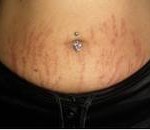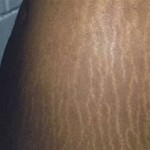
But why stretch marks develop is largely unknown. If you look at the cross-sectional anatomy of a stretch mark you will see that it has a thinned dermal layer to the skin. I often refer to this as an incomplete tear of the skin. The stretching has almost torn its way through the skin so to speak. Herein lies the important thing to known about a stretch mark…it is missing part of the layer of the skin…it is a volume deficiency problem. (like a stretched out rubber band or speaking from a physics perspective, it has gone beyond its elastic deformation limit)

When a problem is difficult to treatment, prevention therefore is the key. Avoiding rapid weight gain is important. For those who are pregnant or experiencing the hormone changes of the teen years, it is crucial to moisturize. Skin becomes more pliant, more plasticized and better able to stretch when it’s well hydrated. One should moisturize three or four times a day with products that contain cocoa butter or shea butter as a prime ingredient. They are very inexpensive and no other topical ingredients have been proven to be scientifically better. Massage the moisturizer deep into breasts, belly, hips, and buttocks.
The appearance of stretch marks depends on the color of your skin. They can start out pink, reddish brown, brown, or dark brown, and fade over time to a more silvery color. Once stretch marks have appeared, it’s essential to treat them as early as possible. Research has focused exclusively on the early stages of stretch marks, when they are still red or purple and numerous treatment strategies have been shown to be beneficial at this point.
While pharmacies and innumerable internet sites tout hundreds of topical stretchmark products, very few of these provide any benefit at all…at least to the patient. It would also be fair to say that home remedies for stretch marks, such as wheat germ oil, are not much help either.
Chemical peels of medical grade variety, however, can be useful. Glycolic acid, a sugar cane derivative and a member of the alpha hydroxy acid (AHA) family, works on stretch marks by increasing collagen production. Widely used for its exfoliative and skin rejuvenation effects, it also helps with collagen production which is a missing element in the skin of the stretch mark. Treatments are inexpensive and it may require three or four peels before results will be visible. When combined with the daily use of retinoids (vitamin A, Retin-A) in between the peels, more collagen formation and elastic production may be induced. The best topical ‘combo’ therapy may be when both chemical peels, Retin-A and Vitamin C (collagen producer) are all combined in a comprehensive topical treatment strategy.
Peptide-containing products, such as Relastin or Strivectin as examples, are widely touted as having skin repair properties. Despite the appeal of these high-tech skin products, there is little evidence at present that they really work as claimed even on facial wrinkles. The activity and the effectiveness of peptides on the skin is more theoretical than fact at present, When it comes to stretch marks, I would be even more skeptical and would save my money until better scientific studies are forthcoming.
The most popular treatment option are differing laser modalities to treat both red/purple and white stretch marks. They appear to work by promoting synthesis of healthy, new collagen, which has been lost in the stretch mark creation process. Several lasers are now FDA-approved for stretch marks which supports some level of effectiveness. Just remember that early treatments in colored stretch marks will be better than in mature white ones.
Dr. Barry Eppley
Indianapolis, Indiana


